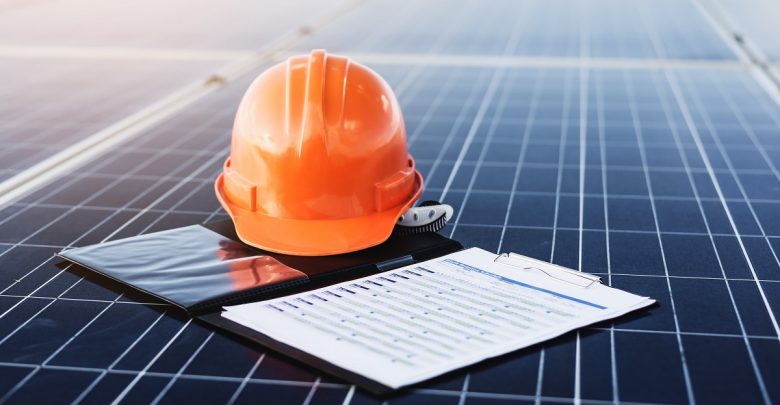In the second instalment of our ‘Personal Guide to Installing Solar at Home’ series, we covered the topics of on-grid vs off-grid vs hybrid systems as well as budgeting. Here is the third post of a five-part series on a personal guide to install solar system at your home. Here, we will be talking about the solar contractor you will need to choose, as well as the importance of a site survey.
Step 5: Choose your Solar installation company
As solar power is new to most residents, people get a little worried about choosing a solar installer. At any point, nearly any homeowner has had to call a handyman, but a solar installation company is something that most homeowners have never interacted with.
Hiring a solar installer is almost the same in several respects as hiring on every home project. Don’t be overwhelmed by the technical existence of the solar photovoltaic system. You’ll be safe with some proper research and the right questions.
The procedure of solar system installation for a home in India is equivalent to recruiting any solar installation company. Do the company’s background analysis, consider the product you are purchasing, and thoroughly read the contract. To remember the best questions to ask, you’ll want to see the company in person and remember to have a checklist in hand.
Everybody loves to save money, but by immediately going for the cheapest quote, don’t look to save money on your solar PV system. In terms of equipment and installation reliability, there are clear differences. Although it is likely that the best installer would also be the cheapest, you can’t tell before you compare the plans and do the homework on the companies. Alternatively, going for the most pricey installer still would not guarantee the best efficiency.
Like we stated in the previous post of this series, you will have to take a note of how much you will want to spend on your solar system installation. Once you have a budget in mind, the next step would be to select a reliable solar installation company.
HomeScape is a trusted brand from the house of Amplus Energy Solutions, a PETRONAS Group Company. Amplus has a project portfolio of 800MW+ across India, and it is one of Asia’s leading distributed energy companies providing customized energy solutions.
A solar system installation for a home in India by HomeScape cuts down up to ninety per cent of your electricity bill and pays for itself in as little as four years. On your investment, HomeScape returns up to 30%, better than any low-risk investment. HomeScape comes in a beautifully built pergola that converts your roof into an area of beauty, created by engineers and designers.

In a photovoltaic system, there are several different parts, and each component is provided with a separate warranty from the manufacturer. Each component and its warranty must be thoroughly explained by the installer. An assurance of the workmanship and components of the machine should be given by the installer, and the labor and maintenance costs of any broken components should be taken care of.
Photovoltaic panels have their warranty, and it comes in two parts: one warranty covering materials and workmanship, and another warranty span covering their production capacity. Normally, solar panels degrade with time, generating a little less power per year. (This loss should be less than 1% per year.)

The module warranty will certify that for years it will continue to generate a specified percentage of the original power output. A twenty-five-year power warranty is common, and a minimum of ten years (often as long as twenty-five years) can be the standard warranty.
At HomeScape, the modules come with a 25 years performance warranty. The breakdown is 10 years for 90% performance and following 15 years for 80% performance. The inverters come with a 5 year warranty which can be extended by AMC. With HomeScape, you will be able to equip your house with solar power in three simple steps:
- Schedule a Site Survey
- Receive your proposal
- Get HomeScape installed
Step 6: Site Survey
The three main factors assessed during a site survey are:
- Feasibility – Is the Solar system installation feasible at the location?
- Viability – Does the Solar installation provide financial benefits in the long term?
- User requirements – Are user requirements correctly understood?
What are the Steps to Perform A Solar Site Survey?
Listed below are the steps to perform a site survey:

Shading Analysis and Roof Orientation
The shading analysis helps you to find the right spot for the installation of the solar panel. To design a proper solar photovoltaic system, this is an essential task. The orientation of the mounted solar panels and the position of the sun have a direct effect on the light incidence. To get maximum solar exposure, you should mount the solar panels in the correct direction.
The solar panels need to be shade-free to get the optimum performance from the solar photovoltaic system. To perform a shading analysis, investigate the movement of sunlight physically. It is the way the sunlight moves over time in a day. Analyze the area and ensure that there are no barriers that cause shading.
Listed below are some of the usual barriers to direct sunlight for your panels:
- Buildings
- Water tanks
- Store rooms
- Chimneys
- Power lines
- Poles
- Hedges
- Neighboring roofs
- Trees
- Hills and other earth obstacles
Roofing Information
Based on the size of both the rooftop room and the panels themselves, we can calculate how many solar modules can fit in the space available. To install the solar PV system most appropriate for your home, review the roof specifications. The installed solar photovoltaic system is customized to suit the house’s roof structure.
- The surface area of the roof (rooftop dimensions)
- Feasibility of the rooftop
- Roof Inclination
- Roof Direction
- The construction material of the roof type
To help you with the site surveying process, the executives from the solar company will take a note of the following:
- Coordinates of the site (Latitude & Longitude)
- Building ownership ( Owned / Leased / Rental )
- Building Roof Height
- Roof type (Flat/ Inclined)
- Shadow free Rooftop Area Available for Solar Installation
- Maximum Load Capacity of the Roof
Usability Check
A usability check helps to determine the user’s accessibility of the solar panels. Consider the following:
- The location of items such as inverter, battery backup and distribution box
- The way the solar PV system connects with the existing electrical system.
Financial Analysis
A financial analysis, as the name suggests, helps you to determine the project’s economic feasibility. From a financial front, consider the following points:
- Financial incentives
- Government subsidies
- Return on Investment

In addition to array positioning and shading details, you may also want to map out a good place to install a central inverter (if you are using one), during your site survey. A point you will have to take a note of is that all the necessary construction regulations should comply. Also, enough room should be provided beneath the solar panels to ensure adequate cooling.
Listed below are the details that you need to analyze before investing in a solar system:
- The rooftop of your home should be shade-free, at least during the sunny six hours of the day
- How much energy you use per day/ per month
- The roof should be in good condition
In conclusion, the third part of our personal guide series focused on choosing the solar installation company and site surveying. Your site survey results and shading evaluation in combination with the energy audit helps you to develop a game plan for the future.
You can now scale your system and start looking for parts to install. A good solar installer will take care of all of the solar installation processes for you, leaving little for you to do. Conducting a site survey is the starting point for a solar system installation for a home in India. We hope you found this article useful.
Read about previous parts of the five-part series here:
Part 1- https://homescape.solar/personal-guide-to-install-solar-at-home-part-1-system-type/
Part 2- https://homescape.solar/personal-guide-to-install-solar-at-home-part-2-system-type-and-budgeting/



